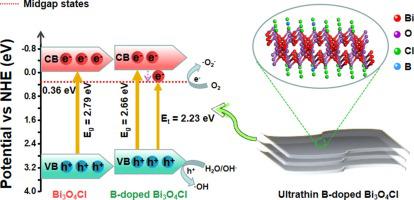当前位置:
X-MOL 学术
›
Appl. Surf. Sci.
›
论文详情
Our official English website, www.x-mol.net, welcomes your
feedback! (Note: you will need to create a separate account there.)
Tailoring the electronic structure of ultrathin 2D Bi3O4Cl sheets by boron doping for enhanced visible light environmental remediation
Applied Surface Science ( IF 6.3 ) Pub Date : 2021-03-01 , DOI: 10.1016/j.apsusc.2020.148521 Yilin Dong , Dongyu Xu , Qiuwen Wang , Guangming Zhang , Quanguo Zhang , Zhiping Zhang , Longyi Lv , Yuguo Xia , Zhijun Ren , Pengfei Wang
Applied Surface Science ( IF 6.3 ) Pub Date : 2021-03-01 , DOI: 10.1016/j.apsusc.2020.148521 Yilin Dong , Dongyu Xu , Qiuwen Wang , Guangming Zhang , Quanguo Zhang , Zhiping Zhang , Longyi Lv , Yuguo Xia , Zhijun Ren , Pengfei Wang

|
Abstract Ultrathin 2D Bi3O4Cl nanosheets are promising photocatalysts for photocatalytic organic pollutions degradation, and tailoring the electronic structure by non-metal element doping of Bi3O4Cl is an important strategy to increase its photocatalytic activity. However, the role of doped non-metal atoms on charge carriers separation and light absorption has not been understood in depth. Here, the B-doped Bi3O4Cl ultrathin nanosheets are fabricated via a solvothermal way, which increase solar absorption and electron-hole separation of Bi3O4Cl. The products are characterized by FE-SEM, TEM, AFM, indicating that B-doped Bi3O4Cl are 3.87 nm thick nanosheets. And UV-Vis-DRS, XPS, PL and density functional theory show that the doped B atoms play multiple roles in facilitating photocatalytic performance: (1) inducing midgap states to immensely expand the light response region up from 450 nm to 557 nm; (2) acting as the electron capture centers to accelerate charge carries separation. The ESR technology shows that B-doped Bi3O4Cl can produce more ·O2- and ·OH radicals. As a result, the B-doped sample achieves a high-efficient photocatalytic bisphenol A and ciprofloxacin degradation, 3-fold and 2.1-fold higher than pure Bi3O4Cl, respectively. This work presents new opinions into the design of photocatalyst and confirms the role of electronic structure modulation on tuning catalytic activity.
中文翻译:

通过硼掺杂定制超薄二维 Bi3O4Cl 片的电子结构以增强可见光环境修复
摘要 超薄二维 Bi3O4Cl 纳米片是用于光催化有机污染物降解的有前途的光催化剂,通过非金属元素掺杂 Bi3O4Cl 来调整电子结构是提高其光催化活性的重要策略。然而,掺杂的非金属原子对电荷载流子分离和光吸收的作用尚未深入了解。在这里,B 掺杂的 Bi3O4Cl 超薄纳米片是通过溶剂热方法制造的,这增加了 Bi3O4Cl 的太阳能吸收和电子空穴分离。产物通过 FE-SEM、TEM、AFM 表征,表明 B 掺杂的 Bi3O4Cl 是 3.87 nm 厚的纳米片。UV-Vis-DRS、XPS、PL 和密度泛函理论表明,掺杂的 B 原子在促进光催化性能方面起着多种作用:(1) 诱导中带隙态将光响应区域从 450 nm 极大地扩展到 557 nm;(2)作为电子俘获中心加速电荷分离。ESR技术表明,B掺杂的Bi3O4Cl可以产生更多的·O2-和·OH自由基。因此,B 掺杂样品实现了高效的光催化双酚 A 和环丙沙星降解,分别比纯 Bi3O4Cl 高 3 倍和 2.1 倍。这项工作为光催化剂的设计提出了新的观点,并证实了电子结构调节对调节催化活性的作用。B 掺杂的样品实现了高效的光催化双酚 A 和环丙沙星降解,分别比纯 Bi3O4Cl 高 3 倍和 2.1 倍。这项工作为光催化剂的设计提出了新的观点,并证实了电子结构调节对调节催化活性的作用。B 掺杂的样品实现了高效的光催化双酚 A 和环丙沙星降解,分别比纯 Bi3O4Cl 高 3 倍和 2.1 倍。这项工作为光催化剂的设计提出了新的观点,并证实了电子结构调节对调节催化活性的作用。
更新日期:2021-03-01
中文翻译:

通过硼掺杂定制超薄二维 Bi3O4Cl 片的电子结构以增强可见光环境修复
摘要 超薄二维 Bi3O4Cl 纳米片是用于光催化有机污染物降解的有前途的光催化剂,通过非金属元素掺杂 Bi3O4Cl 来调整电子结构是提高其光催化活性的重要策略。然而,掺杂的非金属原子对电荷载流子分离和光吸收的作用尚未深入了解。在这里,B 掺杂的 Bi3O4Cl 超薄纳米片是通过溶剂热方法制造的,这增加了 Bi3O4Cl 的太阳能吸收和电子空穴分离。产物通过 FE-SEM、TEM、AFM 表征,表明 B 掺杂的 Bi3O4Cl 是 3.87 nm 厚的纳米片。UV-Vis-DRS、XPS、PL 和密度泛函理论表明,掺杂的 B 原子在促进光催化性能方面起着多种作用:(1) 诱导中带隙态将光响应区域从 450 nm 极大地扩展到 557 nm;(2)作为电子俘获中心加速电荷分离。ESR技术表明,B掺杂的Bi3O4Cl可以产生更多的·O2-和·OH自由基。因此,B 掺杂样品实现了高效的光催化双酚 A 和环丙沙星降解,分别比纯 Bi3O4Cl 高 3 倍和 2.1 倍。这项工作为光催化剂的设计提出了新的观点,并证实了电子结构调节对调节催化活性的作用。B 掺杂的样品实现了高效的光催化双酚 A 和环丙沙星降解,分别比纯 Bi3O4Cl 高 3 倍和 2.1 倍。这项工作为光催化剂的设计提出了新的观点,并证实了电子结构调节对调节催化活性的作用。B 掺杂的样品实现了高效的光催化双酚 A 和环丙沙星降解,分别比纯 Bi3O4Cl 高 3 倍和 2.1 倍。这项工作为光催化剂的设计提出了新的观点,并证实了电子结构调节对调节催化活性的作用。











































 京公网安备 11010802027423号
京公网安备 11010802027423号